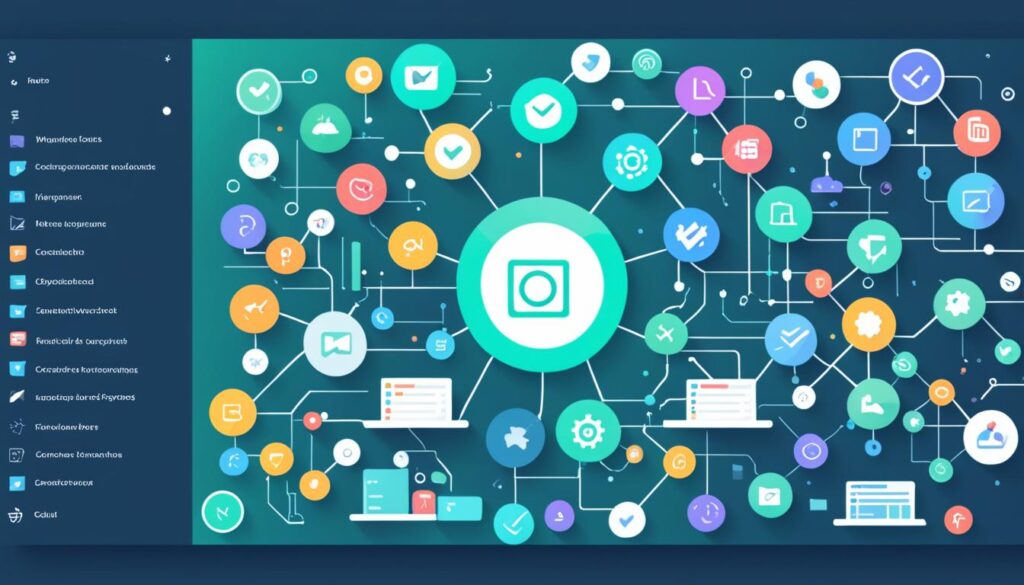Boost Your Developer Productivity Today!

Are you looking to optimize your productivity as a developer? Do you want to achieve more in less time and streamline your workflows? If so, you’re in the right place. In this article, we’ll explore key strategies and techniques to boost your developer productivity. From efficient time management and workflow optimization to the use of powerful software development tools and collaboration platforms, we’ll cover everything you need to know to work smarter and achieve better results. Get ready to take your productivity to the next level!
Key Takeaways:
- Optimizing developer productivity is crucial for software development success.
- Increase efficiency through effective time management and workflow optimization.
- Utilize high-quality software development tools for enhanced productivity.
- Collaboration and project management tools can streamline teamwork and communication.
- Goal setting and task prioritization are essential for productivity improvement.
Selecting the Right Languages and Frameworks
Selecting the right languages and frameworks is a critical decision that can have a significant impact on developer productivity. By carefully choosing languages and frameworks that align with project requirements and the team’s proficiency, you can reduce development friction and empower developers to focus on crafting high-quality solutions.
Popular languages like JavaScript, Python, and Ruby offer flexibility and extensive community support, providing abundant resources for developers to leverage. These languages allow for rapid development and offer a wide range of libraries and frameworks, enabling developers to build robust and scalable applications.
Alternatively, languages like Go and Rust offer efficiency and performance, making them ideal choices for specific use cases that prioritize speed and resource utilization. However, these languages may have a steeper learning curve and a smaller community, which could impact the availability of resources.
When selecting a language or framework, it is crucial to prioritize alignment with project requirements over trends or past successes. By choosing the right tools for the job, developers can work with a sense of confidence, leading to enhanced productivity and job satisfaction.
Benefits of Selecting the Right Languages and Frameworks
- Reduced development friction through alignment with project requirements
- Access to abundant resources and community support
- High-quality solutions and enhanced productivity
- Improved job satisfaction through efficient and effective development

Image: A developer selecting the right programming languages and frameworks.
Providing Access to Quality Developer Tools
Quality developer tools are essential for enhancing your productivity and achieving better results in your software development projects. By providing access to a range of powerful tools, you can create an enriched coding environment that optimizes your workflow and boosts your efficiency.
An effective integrated development environment (IDE), such as IntelliJ IDEA or Visual Studio Code, offers a feature-rich coding environment that enhances your coding experience. With features like intelligent code completion and syntax highlighting, these tools enable you to write code more efficiently and with fewer errors.
Integrated debugging tools further improve your coding process by allowing you to identify and fix issues in your code more effectively. By providing real-time error detection and in-depth debugging capabilities, these tools minimize the time spent on troubleshooting and increase your code quality.
Ensuring code consistency is crucial for maintaining a clean and organized codebase. Linters like ESLint or Trunk automate the process of identifying and fixing code inconsistencies, ensuring that your code follows established coding standards and best practices.
Security tools, such as Snyk, are essential for detecting vulnerabilities in your code early in the development cycle. These tools help you identify potential security risks and address them proactively, enhancing the overall security of your software.
Containerization tools, like Kubernetes and Telepresence, streamline your local development process. They enable you to create isolated development environments and efficiently manage dependencies, resulting in a more streamlined and efficient development process.
By incorporating these quality developer tools seamlessly into your workflow, you can optimize your development process, reduce errors, improve code consistency, and enhance your overall productivity. The right set of tools can make a significant difference in your development journey, empowering you to deliver high-quality software efficiently.

Benefits of Accessing Quality Developer Tools
| Benefits | Description |
|---|---|
| Enhanced coding environment | An enriched coding environment enables you to write code more efficiently, with features like intelligent code completion and syntax highlighting. |
| Improved code quality | Error detection tools and linters help identify and fix code inconsistencies, resulting in cleaner and more maintainable code. |
| Enhanced debugging capabilities | Integrated debugging tools allow for more effective troubleshooting and faster issue resolution. |
| Early vulnerability detection | Security tools identify vulnerabilities in your code early on, reducing the risk of breaches and ensuring code quality. |
| Streamlined development process | Containerization tools simplify the management of dependencies and streamline the local development process. |
Documenting Everything
Proper documentation is the key to maximizing developer productivity. When it comes to navigating the complex world of software development, having comprehensive documentation serves as a reliable roadmap for developers. It allows them to gain a deep understanding of the software architecture and how different components interact with each other.
Good documentation plays a crucial role in reducing cognitive load on developers. By providing clear and concise information, it helps them grasp complex concepts more easily. When new team members come on board, well-documented codebase and processes accelerate their onboarding and enable them to contribute effectively from the start.
Keeping documentation up to date and aligned with code changes ensures that developers have access to reliable information. This is particularly important when making critical decisions that may impact the codebase. Synchronizing documentation with the evolution of the codebase maintains a coherent development environment, minimizing confusion and fostering efficient collaboration.
Benefits of Proper Documentation
1. Improved Codebase Understanding: Documentation provides developers with a clear understanding of the software architecture and how different components fit together, enabling them to work more effectively and make informed decisions.
2. Reduced Cognitive Load: Well-documented code reduces the cognitive load on developers by presenting information in a clear and concise manner, allowing them to focus on problem-solving and innovation.
3. Smooth Onboarding: Comprehensive documentation accelerates the onboarding process for new team members, helping them grasp complex concepts and contributing to the project more quickly.
4. Clarification of Complex Concepts: Documentation serves as a resource for clarifying complex concepts, enabling developers to dive deeper into specific areas of the codebase and gain a better understanding of intricate functionalities.
5. Reliable Information: By keeping documentation current and up to date, developers have access to accurate and reliable information, ensuring they make well-informed decisions throughout the development process.
6. Fostering a Coherent Development Environment: Synchronizing documentation with the codebase evolution creates a more coherent and efficient development environment, reducing confusion and promoting better collaboration among team members.

Having proper documentation is an investment that pays off in the long run. It empowers developers with the knowledge they need to navigate the codebase, make informed decisions, and contribute effectively to the project. By reducing cognitive load, aiding onboarding, and providing reliable information, documentation acts as a foundation for a coherent and productive development environment.
Reducing Cognitive Load
Reducing cognitive load is vital for enhancing developer productivity. By minimizing the number of meetings and establishing clear objectives, you can create an environment that allows developers to focus on coding and problem-solving.
Meetings can often disrupt workflow and take up valuable time. To minimize their impact, it’s important to only schedule meetings when necessary and involve only essential personnel. This helps to ensure that meetings stay focused and productive, rather than becoming a drain on productivity.
In addition to reducing meetings, fostering asynchronous communication can also help reduce cognitive load. Tools like Slack enable developers to address queries and engage in discussions at their convenience, without interrupting their workflow. This allows for more uninterrupted work time and helps developers maintain their focus and productivity.
Another way to reduce cognitive load is by leveraging AI tools. These tools can help automate repetitive tasks and provide creative stimulation to developers. They can also facilitate continuous learning by offering insights and suggestions for improvement. By integrating AI tools into the development process, you can enhance productivity and encourage innovation.
Lastly, creating a supportive environment that embraces failure as a stepping stone to innovation is essential. When developers feel accepted and supported in their failures, they are more likely to take risks and push the boundaries of their creativity. This leads to greater motivation and a more productive work environment.

List of Strategies to Reduce Cognitive Load:
- Minimize the number of meetings
- Establish clear meeting objectives and agendas
- Encourage asynchronous communication
- Utilize AI tools to automate tasks and stimulate creativity
- Create a supportive environment that accepts failure
| Strategies | Benefits |
|---|---|
| Minimize the number of meetings | Allows for more uninterrupted work time |
| Establish clear meeting objectives and agendas | Makes meetings more productive and less disruptive |
| Encourage asynchronous communication | Reduces interruptions and allows for flexible work schedules |
| Utilize AI tools to automate tasks and stimulate creativity | Enhances productivity and encourages innovation |
| Create a supportive environment that accepts failure | Fosters motivation and a positive work culture |
Encouraging Innovation and Autonomy
Encouraging innovation and autonomy is essential to creating a positive developer experience and boosting productivity. As a software development organization, providing your developers with the freedom to innovate and experiment with new ideas is crucial. This freedom stimulates creativity, fosters a sense of ownership, and empowers them to seek better solutions.
By creating an environment that values exploration, you not only stimulate creativity but also encourage continuous learning. When developers are encouraged to learn new technologies and methodologies, they can adopt more efficient development strategies and approaches. This continuous learning culture fosters growth and adaptability within your team.
Embracing autonomy is equally important. Offering developers autonomy in their decision-making allows them to take ownership of their work and become more invested in their projects. Autonomy empowers developers to make decisions based on their expertise and gives them the flexibility to explore creative solutions. This sense of ownership and responsibility promotes a positive developer experience and leads to improved outcomes.
Benefits of Encouraging Innovation and Autonomy
When developers are encouraged to innovate and given the autonomy to explore new ideas, your organization can experience several benefits:
- Increased creativity: Developers are empowered to think outside the box and come up with innovative solutions, leading to unique insights and approaches.
- Continuous learning: By embracing innovation, developers are motivated to stay up-to-date with the latest advancements in their field, fostering continuous learning and professional growth.
- Improved problem-solving: Autonomy allows developers to approach problems from different angles, leading to more effective and innovative solutions.
- Enhanced productivity: When developers are encouraged to think creatively and take ownership of their work, they become more engaged and productive.
- Positive developer experience: Creating an environment that values innovation and autonomy contributes to a positive developer experience, increasing job satisfaction and retention rates.
- Better outcomes: The combination of creativity, continuous learning, autonomy, and a positive developer experience ultimately leads to improved outcomes for your organization.
| Benefits of Encouraging Innovation and Autonomy | Description |
|---|---|
| Increased creativity | Developers are empowered to think outside the box and come up with innovative solutions, leading to unique insights and approaches. |
| Continuous learning | By embracing innovation, developers are motivated to stay up-to-date with the latest advancements in their field, fostering continuous learning and professional growth. |
| Improved problem-solving | Autonomy allows developers to approach problems from different angles, leading to more effective and innovative solutions. |
| Enhanced productivity | When developers are encouraged to think creatively and take ownership of their work, they become more engaged and productive. |
| Positive developer experience | Creating an environment that values innovation and autonomy contributes to a positive developer experience, increasing job satisfaction and retention rates. |
| Better outcomes | The combination of creativity, continuous learning, autonomy, and a positive developer experience ultimately leads to improved outcomes for your organization. |
Implementing Developer Playbooks
Implementing developer playbooks is a key strategy to optimize productivity and ensure consistent, high-quality results in software development. These playbooks provide structured solutions and best practices for common tasks and challenges, eliminating the need for developers to reinvent the wheel or spend excessive time on routine activities.
By utilizing standardized procedures, coding standards, and templates, playbooks promote consistency and efficiency throughout the entire development lifecycle. Developers can rely on these established guidelines to streamline their workflows and focus on the value-added aspects of their projects.
Moreover, developer playbooks facilitate knowledge transfer within the team, allowing developers to leverage the collective experience and insights of their peers. This promotes better-informed decision-making and solutions that are grounded in years of industry best practices.
Access to well-curated playbooks also accelerates development cycles, enabling teams to deliver software solutions with greater speed and agility. By implementing these structured approaches, organizations can improve code quality and maintainability, leading to more robust and sustainable software products.
Overall, implementing developer playbooks empowers development teams with standardized and efficient processes, ensuring that best practices are followed, code quality is maintained, and accelerated development cycles are achieved. This ultimately results in a more productive and satisfactory developer experience, yielding remarkable outcomes for software development organizations.
Benefits of Implementing Developer Playbooks
By implementing developer playbooks, your organization will experience a plethora of benefits:
- Structured solutions: Playbooks provide step-by-step guidance and predefined approaches to address common development challenges, ensuring a structured and systematic approach.
- Best practices: Playbooks incorporate industry best practices, enabling your development team to leverage proven strategies for optimal results.
- Standardized procedures: By following established procedures outlined in playbooks, your team can work cohesively and reduce inconsistencies in development processes.
- Coding standards: Playbooks define coding standards, ensuring consistency across your codebase and making it more readable and maintainable.
- Template utilization: Playbooks offer pre-built templates for common tasks, saving time and effort by providing ready-to-use solutions.
- Knowledge transfer: Playbooks facilitate the transfer of knowledge within your team, fostering collaboration and empowering developers with collective expertise.
- Accelerated development cycles: With playbooks, your team can work more efficiently, reducing development time and accelerating project delivery.
- Code quality and maintainability: Following playbooks ensures code quality and maintainability, leading to more robust and manageable software products.
By embracing developer playbooks, you empower your team with the tools and resources they need to excel in their roles. The structure, best practices, and standardized procedures provided by playbooks translate into enhanced productivity, improved code quality, and streamlined development processes.
Take the first step towards implementing developer playbooks and unlock the full potential of your development team.
Conclusion
Developer productivity is a critical factor in the success of software development organizations. By implementing optimization strategies and focusing on key factors such as language and framework selection, access to quality developer tools, documentation, cognitive load reduction, innovation, autonomy, developer playbooks, and automation of repetitive tasks, you can enhance developer productivity and achieve better outcomes.
Streamlined workflows, increased efficiency, and better results can be achieved by utilizing the right tools and creating an environment that fosters creativity, learning, and collaboration. The selection of languages and frameworks that align with project requirements and the team’s proficiency is crucial for minimizing development friction and delivering high-quality solutions. Providing access to quality developer tools, such as integrated development environments and security tools, enriches the coding environment and ensures code consistency and error detection.
Proper documentation serves as a roadmap to the codebase, reducing cognitive load and facilitating onboarding and codebase evolution. Additionally, reducing cognitive load by minimizing meetings, embracing asynchronous communication, and utilizing AI tools stimulates creativity, continuous learning, and positive developer experience. Encouraging innovation and autonomy empowers developers to explore new ideas, adopt efficient development strategies, and contributes to improved outcomes.
Implementing developer playbooks standardizes procedures, accelerates development cycles, and enhances code quality and maintainability. By focusing on these key factors and utilizing the right tools, you can optimize developer productivity, streamline workflows, and achieve better results while maintaining a focus on quality.






